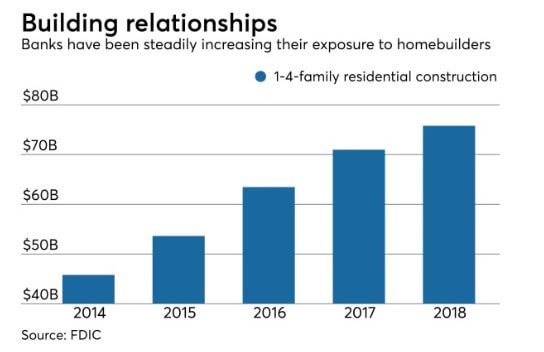Lenders tread carefully in return to homebuilder finance
August20 2018, 2:01pm EDT
Several banks, still mindful of the last housing implosion, are easing back into homebuilder finance.
When the housing bubble burst in 2008, it left many builders with scores of empty homes and unsold lots – and crippling debt. The demise of many of those developers contributed to the failure of numerous banks.
With the passage of time, some banks have geared up to make more homebuilder loans.

Flagstar Bancorp in Troy, Mich., formed a national homebuilder platform in 2016, and in June Umpqua Holdings in Portland, Ore., hired a new head for its homebuilder finance group with an eye on expansion in California. Bank of Nevada, a unit of Western Alliance Bancorp. in Phoenix, recently touted efforts to lend more to homebuilders around Las Vegas.
To be sure, growth-minded banks are more cautious than they used to be, industry experts said.
“The amount of due diligence paperwork and the amount of information that the [borrower] has to provide to the lender is extremely burdensome,” said Ruth Razook, founder and CEO of RLR Management Consulting. “Now every single item appears to be scrutinized.”
Much of that scrutiny is a result of heightened regulatory oversight after the financial crisis, Razook said, adding that mortgage requirements are “extremely difficult.”
Still, loans tied to one- to four-family residential construction rose 7% in the first quarter from a year earlier, to $76 billion, according to data from the Federal Deposit Insurance Corp. That number is down 63% from the first quarter of 2008.
Banks are returning to homebuilder finance because the transactions are simple to understand, said Greyson Tuck, an attorney and consultant at the legal and consulting firms of Gerrish Smith Tuck. Real estate values are rising, reducing loan-to-value ratios and bolstering the value of the underlying collateral.
“As home values increase, the chances [that the lenders] may take a loss on a house if the borrower cannot repay and they have to foreclose and take the house decreases,” Tuck said.
Flagstar launched its national platform after hiring a team from Texas Capital Bancshares. Its homebuilder loan commitments rose by 85% in the first quarter from a year earlier, to $1.4 billion, according to Joe Hardy, Flagstar’s managing director of homebuilder finance.
Nate Tower, equity research associate at Stephens Inc., noted that Flagstar’s portfolio is much smaller than what the $18.1 billion-asset company had before the last recession. The portfolio’s loss rate last year was less than 1%, marking a notable improvement from the nearly 17% rate from 2010.
Underwriting fundamentals are stronger today, Hardy said. Lenders require borrowers to put more equity into deals. Homebuilder finance also has more comprehensive covenant packages, stricter monitoring for compliance and regular reporting from borrowers.
Flagstar has a reason to remain cautious. It was burned during the financial crisis after becoming overly exposed to the mortgage industry. (It was recently freed from a crisis-era regulatory order.)
The banking industry must remain vigilant, industry experts warned.
Banks are “looking at the short-term historical metrics which falsely reassure the market is bullet proof,” said Melissa Abel, executive vice president of builder finance at the $24 billion-asset Texas Capital in Dallas.
“In the builder finance space,” Texas Capital “is looking for more liquidity, less leverage, and a considerably strong recurring cash flow stream,” Abel said.
While bankers have learned lessons from a decade earlier, they must be attentive to ongoing challenges for builders.
Residential development “hasn’t fully recovered from the last downturn,” said David Ledford, executive vice president of housing finance and regulatory affairs at the National Association of Home Builders.
Sales of new homes have been sluggish; June sales fell 5.3% from May and were relatively flat from a year earlier, based on the most recent data from the Census Bureau and the Department of Housing and Urban Development.
At the same time, residential developers aren’t building that many new homes.
New-home construction fell 1.4% in July from a year earlier, to a seasonally adjusted annual rate of nearly 1.2 million units, according to a projection from the Census Bureau.
A key factor is higher materials costs, specifically Canadian lumber imports. Since early 2017, higher lumber costs have increased the market value of a new multifamily home by about $2,500 and the average price of a new single-family home by nearly $6,400, according to a study by economists of the National Association of Home Builders.
Escalating rhetoric over tariffs is creating concern that the costs of additional materials will rise, which could curtail new construction even more.
“All of this could potentially create affordability pressures going forward,” said Jade Rahmani, an analyst at Keefe, Bruyette & Woods.
